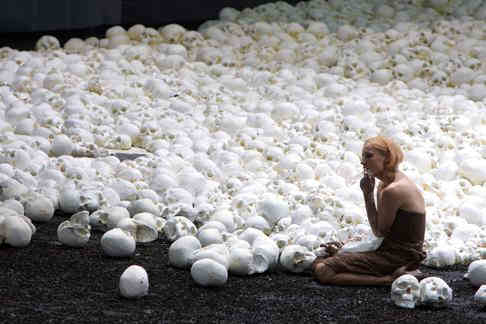Other Links
Editorial Board
- Editor - Bill Kenny
- London Editor-Melanie Eskenazi
- Founder - Len Mullenger
Google Site Search
SEEN
AND HEARD INTERNATIONAL OPERA REVIEW
Verdi,
Macbeth: Bavarian State Opera: Soloists, Bavarian
State Opera Orchestra,
Nicola Luisotti
(conductor) Nationaltheater, Munich 2.10.2008 (JFL)
Production Team
Martin Kušej
(direction)
Martin Zehetgruber (sets)
Werner Fritz (costumes)
Reinhard Traub (lighting)
Macbeth
Zeljko Lucic
(Macbeth)
Nadja Michael (Lady Macbeth)
Roberto Scandiuzzi (Banco)
Lana Kos (Dama di Lady Macbeth)
Dimitri Pittas (Macduff)
Fabrizio Mercurio (Malcolm)

Delight at the athletic, seductive Lady Macbeth who, in Michael’s
ravishing (almost cloyingly so) interpretation, becomes Salome’s
Scottish sister with a penchant for conspiracy as an (a)rousing
activity.
From limber acrobatics in the lowered chandelier to her particularly
detailed rhythmic articulation to her dramatic, wildly vibrating yet
piercing voice (neither incapacitated by a cold, as
Intendant
Klaus Bachler had announced, nor quite as ugly in tone as
Verdi had intended) she was a Lady Macbeth to die– or rather: to
murder for.
Disgust at the band of extras and chorus members that director
Martin Kušej sends downstage to micturate all over the place at the
opening of the third act, and for no less than an astounding three
minutes. (Though maybe the audience was merely jeering because
choreographed urination is such a clichéd element in European Verdi
direction.) When 13 topless playboy bunnies with pink wigs
(undoubtedly the wind spirits) appeared shortly thereafter, a smart
aleck yelled “bravi”, creating an unusual amount of merriment during
a performance of as dark an opera as Macbeth. At about this point,
the show was at the verge of being hijacked by the audience;
laughter, lusty boos from every tier, and blatant chatter created a
casual, irreverent atmosphere rarely encountered in modern opera
houses. Slightly rowdy, perhaps, but quite enjoyable in its way.
Enjoyable like Zelijko Lucic, the Serbian baritone who sang Verdi,
instead of pushing it, his voice ringing effortlessly through the
round of the Staatsoper, more impressive even than the very fine
Banco of Roberto Scandiuzzi whose severed head would became the
play-toy of Lady Macbeth.
And enjoyable like the homogenously playing Bavarian State Orchestra
under Nicola Luisotti who got a salvo of boos, but deserved the many
more bravos for his nervous, restless reading that had all the
accents in the right places and made great music of what Verdi
supplied him with.
Kušej (whose
Salzburg La Clemenza di Tito is my measure of
direction excellence) and his stage designer Martin Zehetgruber
created many fine views: the vast field of skulls over which the
protagonists climb the entire time and the walls of plastic sheets
(á la Guy Ritchie’s “Snatch”)
all make good, unsubtle points.
But too many ideas seem unfiltered and crass, as if Kušej’s team had
had no time to filter out the unnecessary ones, or distinguish
between the obvious and the obscure. The handful of blond children
(modeled after
Village of the Damned)
that variously represent the witches, fate, and murdered innocents.
The obsession with Banco’s severed head. The constant dressing and
undressing of the chorus (nakedness, medieval costumes, grimy
underwear). It all veered between gratuitous, pointless, and too
dense. It made for a production worthy of praise and mockery alike —
a curious (in the best and worst sense of the word) opening for the
new Bachler regime at Germany’s most important opera house.
Jens F. Laurson
Picture © Michael Hoesl
Back
to Top
Cumulative Index Page
